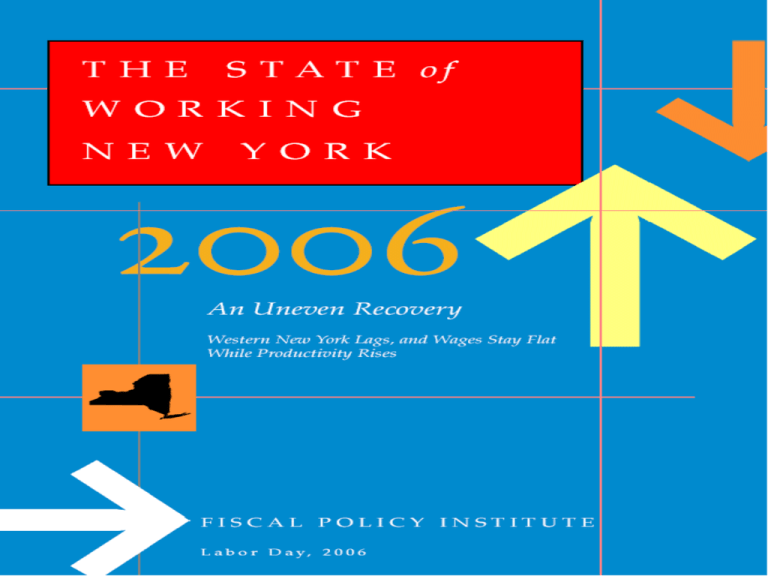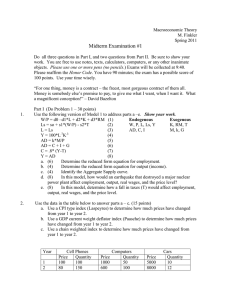Document 17754990
advertisement

Regional economic distinctions are essential in better understanding New York’s economic challenges As we enter the 4th year of recovery nationally, New York has not yet recovered the jobs lost in the last recession. Employment First half of 2001 Employment First half of 2006 Change – Absolute Change Percentage US 131,882,300 134,490,300 +2,608,000 +2.0% NYS 8,615,100 8,539,800 -75,300 -.9% NYC 3,717,100 3,628,200 -88,900 -2.4% Eastern NY 2,622,900 2,684,200 +103,800 +2.3% Western and Northern NY 2,275,700 2,230,300 -45,400 -2.0% New York’s economic performance in recent years has fallen considerably short of its potential Since 2000, the average annual rate of employment growth, real per capita income growth and real wages for New York State as a whole have all been close to ZERO Only region with growth in employment and real wages was Eastern New York Western and Northern NY experienced declines in employment and real wages, slight increase in per capita income only due to population decline NYC declined on all three indicators Western and Northern NY economies are particularly distressed Population has been declining, particularly suffered loss of young adults aged 20-34 This region did not benefit from the “boom” of the late 1990s – job growth less than half the state average Not hit as hard by the recession but employment has not recovered Upstate metropolitan areas (Binghamton, Buffalo, Elmire, Ithaca, Rochester, Syracuse and Utica-Rome) have lost 42,000 jobs since 2001 NYC was hit hard by the recession but seems to be recovering. Between the first half of 2003 and the first half of 2006 payroll employment grew by 2.9% - 104,000 jobs For the first half of 2006, NYC’s job growth was 1.6%, more than twice the national job gain New York City lost 193,000 jobs during the recession --- still 89,000 below level for the first half of 2001 Eastern NY has done better than the nation as a whole. Eastern NY includes the Hudson Valley, the Capital District and downstate suburbs – Long Island, Westchester, Rockland and Putnam Counties This region has seen a growth in payroll employment – since 2000 has done better than the nation as a whole 2.3% growth vs. 2.0% growth nationally 63,000 jobs in the past three years – only lost 1,700 in the recession Manufacturing employment continues to be the predominant economic driver in Western NY Many of NY’s manufacturing industries are among the most productive in the nation. The current recovery has not seen an increase in median real wages. Even in NYC – real median wages are still below the 2002 level. While NYS output per worker increased by 9.3% between 2000 and 2005, the average real wage is only 1.6% higher in 2005 than in 2000. NY has the widest top-bottom income gap among all states Average income of families in the top quintile 8.1 times greater than average income of families in bottom Sixth widest gap between rich and middle quintile Only in the 1990s did the middle and lower quintile families experience real income gains. Evidence suggests that during this recovery, the gap is widening. For 2005, New York’s 14.5% poverty rate was almost two percentage points higher than than the national poverty rate. 18 New York U.S. 17 16 15 14 13 2005 2004 2003 2002 2001 2000 1999 1998 1997 1996 1995 1994 1993 1992 1991 1990 1989 1988 1987 1986 1985 1984 1983 1982 1981 11 1980 12 Poverty rates in Syracuse, Rochester, Buffalo, Albany and NYC are even higher. Health care coverage and rising health care costs are major cost challenges facing NY The share of the population in NY without health insurance coverage has fallen thanks to expanded public coverage but 2.6 million people are still have no health insurance. State fiscal actions have compounded local fiscal stress and hindered economic recovery The tax cuts enacted since 1994 will reduce state revenues by almost $16 billion during the 2006-2007 fiscal year. $20 Revenue impact, in billions of tax cuts enacted in 1994-95 through 2005-06. $15.43 $16 $15.82 $14.08 $12.77 $13.23 $12.01 $12 $11.21 $8.97 $7.32 $8 $6.12 $4.22 $4 $1.44 $0.47 $0 1994-05 1995-96 1996-97 1997-98 1998-99 1999-00 2000-01 2001-02 2002-03 2003-04 2004-05 2005-06 2006-07 One bright spot – the increase in the minimum wage did not dampen job growth among low-wage workers NYS minimum wage went up from $5.15 an hour to $6.00 an hour on January 1, 2005. Will increase to $6.75 in 2006 and $7.15 in 2007 No evidence of job losses in retail trade or food services --- NY grew faster than other states in region and as fast or faster than nation as a whole No decrease in hours worked either Figure 2.14 Employment in New York, four neighboring states, and the U.S. Before and after January, 2005, New York minimum wage change Employment (000s) First half of 2004 First half of 2005 New York State All non-farm 8,383 8,463 1.0% 849 441 864 453 1.8% 2.7% 14,532 1.2% 1,655 841 1,679 863 1.5% 2.7% 130,518 132,708 1.7% 14,866 8,741 14,998 8,993 0.9% 2.9% Retail trade Food service Four neighboring states (NJ, PA, MA, CT) All non-farm 14,365 Retail trade Food service United States All non-farm Change Retail trade Food service Note: Retail trade and food services are the largest employers of minimum-wage workers. Source: Bureau of Labor Statistics


